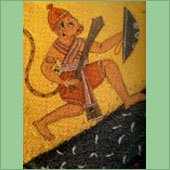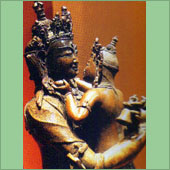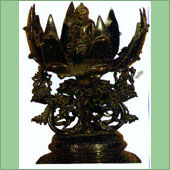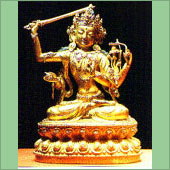
according to Hindu mythology, are heavenly nymphs
who were originally associated with water and later with the countryside. According
to the great epic, the Ramayana, their origin can be traced to the churning
of the ocean. When the Apasaras emerged from the water, neither the gods
nor the ASURAS wanted to marry them, so they belonged to everyone and were known
as the "Daughters of Joy" .
The
Apsaras are charming and beautiful dancers, and are said to be fond of games of
chance. However, according to one tradition, they can also cause madness. They
are sometimes said to live in fig trees and banana plants.
are "enlightenment
begins" who are destined to become Buddha. They put off the moment when they
will enter nirvana and escape the cycle of death and rebirth, in order that
they may help others along the long part to enlightenment. Bodhisattva are thus
living symbols of compassion.
According
to Mahayana, or "Great Vehicle" Buddhism, human beings are some times able
to enter paradise by means of a bodhisattva's merits and spiritual power
rather than through their own, provided that they call on the bodhisattva in
faith.
BODHISATTVAS ARE FUTURE BUDDHA. They have such compassion for humanity that they
take a vow to attain enlightenment, not just for their personal liberation but
to show others the path they have found. In Mahayana Buddhism, this means that,
even though they have reached the threshold of nirvana, they delay their own
freedom and resolve to stay in the world to help outers. For them, their own
achievement of nirvana is not their only goal. They perceive further stages of
enlightenment to be attained on the route to becoming a Buddha. Celestial
bodhisattvas, such as Manjushri and Avalokiteshvara, are very near to becoming Buddha
themselves, and they act as mediators between the Buddha and mortals. They are
not monks, but lay figures who are often portrayed as princes, wearing elaborate
jewelry and a five-leaved crown. The bodhisattva Maitreya is the Buddha of the
future, a benevolent character who will arrive on earth in about 30,000 years,
when the Buddhism of the present age has expired.
Bodhisattvas
are usually shown robed as Princes, wearing five-leaved crowns. AVALOKITESHVARA
and MANJUSHRI are tow of the best known bodhisattvas.
AVALOITESHVASA
is the most popular BODHISATTVA OR
"buddha-to be" of Mahayana or "Great Vehicle" Buddhism. His name is
translated as "Lord of Compassionate Sight" or "Lord Who Looks From On
High". The Bodhisattva of the present age, Avalokiteshvara is said to have
emanated from the great Buddha AMITABHA.
Although his residence is in Amitabha's paradise, he remains in this world in
order to attend to the salvation of humans and animals. He is usually
represented as a handsome man, with several heads and arms.
According
to one myth, when Avalokiteshvara was looking down on the suffering in the
world, his head burst open in pain. Amitabha put the pieces back together as
nine new heads. Then, because Avalokiteshvara wanted to help all creatures, he
grew 1000 arms, and in the palm of each hand was an eye: "From his eyes were
derived the sun and the moon, from his forehead, Mahesvara, from his shoulders, BRAHMA
and other gods, from his heart, Narayana, form his things, SARASVATI,
from his mouth, the winds, from his feet, the earth, from his belly, VARUNA."
Avalokiteshvara
helps everyone who asks for his assistance. He visits hell to take cooling
drinks to those suffering the heat the damned, and he preaches the Buddhist law
to beings incarnated as insects or worms. He is also said to protect people from
natural disasters and to bless children. Moreover, the bodhisattva is said to
have converted the female ogres of Sri Lanka and to have been given the task of
converting Tibet to Buddhism.
In
Tibet, his name is Pyan-rasgzigs or CHENREZIG.
In China, Avalokiteshvara developed into the goddess Kuan Yin, or Guanyin, and
in Japan into the god, or sometimes goddess, Kwannon.
are his incarnations on earth in order to help humankind
in moments of great crisis. It is generally accepted that Vishnu has ten avatars,
although their number varies, and their identities are also flexible. Usually,
the incarnations are said to consist of Matsya, KURMA, Varaha, NARASIMHA,
Vamana, Parashurama, RAMA, KRISHNA, GAUTAMA BUDDHA and
Kalkin.
back to top
according to Hindu
mythology, was the creator and director of the universe. He was the father of
gods and humans alike, and in classical Indian thought, he forms a trinity with
VISHNU and SHIVA. The three gods are collectively known
as the Trimurti. Vishnu and Shiva represent opposing forces and Brahma, the
all-inclusive deity, represents their balancing force.
Brahma
was also the personalized form of Brahman. Originally, this term referred to the
sacred power inherent within a sacrifice, but it came to refer to the power,
known as the "Absolute", which lay behind all creation.
While the god Brahma meditated, he produced all the material elements of the
universe and the concepts that enabled human beings to understand them. In each
day of Brahma's existence, the universe is created, and in each night, it is
reabsorbed. Within each of these cycles, there is four successive ages, or YUGAS,
beginning with the Krita Yuga, or golden age, and ending with the Kali Yuga, the
present age of conflict and despair.
back
to top

according to Hindu mythology, was the prince of birds and the son of the sage KASYAPA. According to one account of Garuda's birth, Kasyapa had two beautiful wives, Kadru and Vinata. The sage promised to provide both wives withheirs. Kadru chose to give birth to 1,000 splendid serpents, whereas Vinata asked for only two sons. However, Vinata requested that her sons' strength and prowess should surpass that of Kadru's offspring. Eventually, Kadru laid 1,000 eggs and Vinata laid tow. After 500 years, 1,000 serpents emerged from Kadru's eggs. However, Vinata's tow sons failed to appear. Impatient, Vinata broke open one of her eggs to find and embryo with only the upper half-developed. The embryo became Aruna, the red glow of dawn. Aruna cursed his mother and ascended into the sky, where he remains to this day. Another 500 years passed and Vinata's remaining egg finally broke open to reveal Garuda. Another tale tells how, in order to free herself from a curse, Vinata was forced to acquire AMRITA, the elixir of immortality and to give it to her nephews, the 1,000 serpents. Vinata asked Garuda to seize the drink from the gods and, after a mighty struggle, he succeeded in doing so. He put the drink down in front of the serpents, but said that they must purify themselves before drinking it. While they were busy performing their ablutions, INDRA retrieved the Amrita, as had been previously arranged with Garuda. Garuda was a devotee of VISHNU, the preserver of the universe, and he was chose by the god to be his mount. He appeared whenever summoned by Vishnu's thought, and fought with him against demons and demonic serpents. Garuda is depicted with the head, wings and claws of an eagle. In Buddhism, garudas are divine bird-like creatures. back to top to top
JAINISM
IS AN INDIAN RELIGION and philosophy, which offers an austere path to
enlightenment. Much of its mythology was inherited from Hinduism, including huge
numbers of gods, and ideas on the structure of the universe, but Janis differ
from Hindus in that they do not believe in the idea of creation, considering
that time is cyclic. Jain ascetics attempt to conduct their lives following five
vows: to injure no living thing (because everything has a soul); to speak the
truth; to take only what is given; to be chaste; and to achieve detachment from
places, people and things. Their examples in following this discipline are 24
tirthankaras, or "spiritual teachers", who have appeared in the present
cycle of time. A tirtha is a ford or
crossing-place, or a sacred place, person or path, which enables believers to
cross over into, liberation from an endless round of rebirth: for Jains, the
tirthankaras were the builders of the ford.
back
to top
to top
THE GUARDIAN KINGS, according to Buddhist belief, guard the four quarters of the world and protect the Buddhist law. They are said to live on the mythical Mount MERU, at the gates of the paradise of INDRA, the protector of Buddhism. The Guardian Kings are acolytes of the BODHISATTVA AVALOKITESHVARA. Originally, they were regarded as benevolent, but they developed into menacing warriors. They are usually shown wearing armor and helmets or crowns. The kings are said to have assisted at the birth of GAUTAMA BUDDHA and to have held up the hooves of his horse when he left the palace of his father for the outside world. In Indian art, they are usually shown riding elephants, whereas in Tantrism they are often shown trampling demons. back to top

HEVAJRA is a YIDAM, or tutelary god, worshipped in Mongolia, Cambodia, Thailand and Tibet, He is usually represented with four legs and eight heads; his body is blue, and his heads are different colors. He is sometimes shown alone, but often in Yab-Yum, the posture of embrace, with his SHAKTI or corresponding female energy. back to top
INDRA one of the chief deities of Indian mythology, is a god of storms and war. He appears in the Rig-Veda - the ancient hymns forming part of the Veda, the sacred knowledge of Hinduism - as the king of the gods. Indra is red or gold in color, and is large, fierce and warlike. In his right had he carries a thunderbolt, which he uses either to slay his enemies or to revive those killed in battle. He is said to ride through the heavens in a chariot, often said to be the sun. In later times, he was frequently depicted on the elephant, AIRAVATA. back to top
KALI the "Black One", is the terrifying aspect of the great mother goddess and SHAKTI of SHIVA. The personification of death and destruction, she is said to spring from the forehead of DURGA, another aspect of the goddess, when she becomes angry. Kali is usually depicted with blood-red eyes, four arms and with her tongue lolling out of her mouth in search of blood. She is naked, but for a girdle of severed heads or hands, a necklace of skulls sand a tiger skin. Like Shiva, Kali has a third eye in her forehead. In one hand she holds a weapon, in another the severed head of a giant, while her remaining two hand, in contrast, are raised in blessing. Her devotees regard her as loving mother goddess who can destroy death as well as demons. back to top
KRISHNA According to Hindu mythology, is an AVATAR of VISHNU, the preserver of the universe. He is traditionally referred to as the only complete avatar. A divine hero, krishna is said to have been miraculously born in the town of Mathura in northern India. The gods wanted to destroy the evil oppressor King Kamsa, and so Vishnu decided to be born as the eighth son of the king's sister Devaki. According to none story, Vishnu plucked out two of his hairs, one black, one white. The black hair became Krishna and the white hair BALARAMA, Krishna's older brother. Krishna's name means the "Dark One".. back to top
NAGAS, according to Hindu belief, are semi-divine but powerful serpents that guard the treasures of the earth. They are often associated with fertility but can occasionally prove dangerous. Whereas some nagas are depicted with several heads, others are represented as human beings. The naga Vasuki was used as a rope in the myth of the churning of the ocean and was afterwards worn by SHIVA as a girdle that had the power to dispel demons. When the great god VISHNU is resting, he sleeps on the naga known as Sesha, or Ananta. Seshas's hoods shade the god, but his yawns cause earthquakes. back to top
THE MOTHER GODDESS, DEVI, OR MAHADEVI ("THE GREAT GODDESS"), is a composite figure who includes various aspects of the female deity in a series of contrasting incarnations. In the earliest Indian cultures, the mother goddess was Shakti, the source of all energy in the universe, the creative force who brought fertility to the earth. Some of her manifestations were associated with natural forces, such as Ushas, the dawn, and Ganga, the river. Later she was subsumed in the patriarchal Hindu creation myth as the on sort of Shiva. In this role she continued to appear in a variety of incarnations. Some were benign, such as Sati and Parvati, both of whom were loving and caring, but others were terrifying, such as the warrior goddesses Durga and Kali. Although she lost her autonomy in her new role as consort, she was still the creative force. While Shiva embodied potency, Shakti was the energy needed to release his power. back to top




VISHNU is one of the most important gods of Hinduism and the most widely worshipped Together with SHIVA and BRAHMA, he belongs to the triad of great gods known as the Trimurit. The preserver of the world, Vishnu is majestic and at times terrifying. One the whole, however he is a benevolent deity and far less frightening than Shiva. Vishnu's devotees, the Vaishnavas, regard him as the supreme god: one of his many epithets is the "Highest God". Brahman, the Hindu concept of the "Absolute" or supreme reality, is sometimes depicted as Vishnu. back to top
khmer statue:thai handicraft:asian handicraft:tantrism:Handicraft thailand:buddha antique:bronze buddha